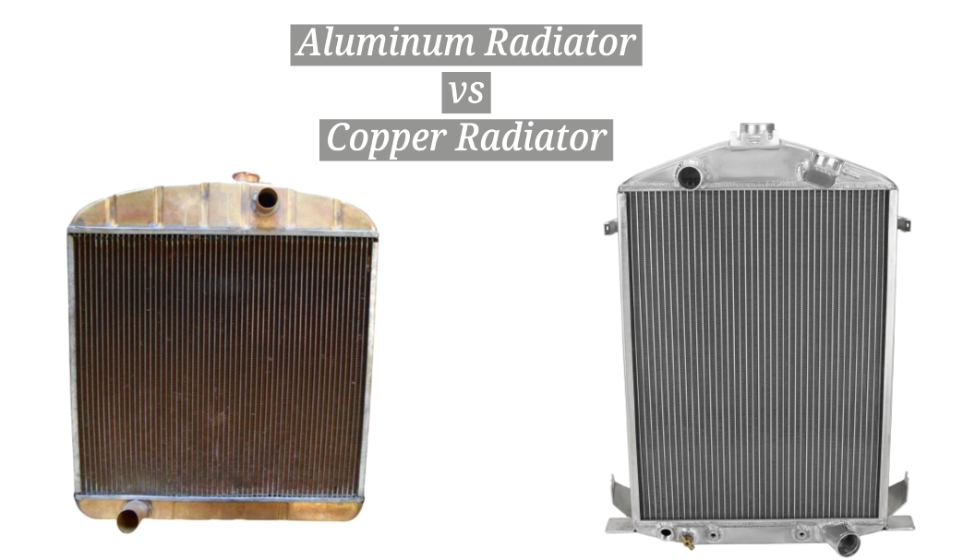Car radiators cool the engine while condensers cool the refrigerant in an air conditioning system. Car radiators dissipate heat, while condensers release heat; they serve different functions.
When driving, the heat produced by the engine must be dissipated to prevent overheating, which is where the radiator comes in. On the other hand, the condenser is essential for maintaining the efficiency of the air conditioning system by removing heat from the refrigerant.
Understanding the differences between these two components is crucial for ensuring optimal performance and longevity of your vehicle. Let’s delve deeper into the distinctions between car radiators and condensers to appreciate their unique roles in the functioning of an automobile.

Credit: www.motoreasy.com
2. Understanding The Cooling System
The cooling system of a car plays a crucial role in maintaining the engine’s performance and preventing overheating. In this section, we will explore the importance of the cooling system and its various components to help you better understand how it works.
2.1 The Importance Of The Cooling System
The cooling system is like the heart of your car’s engine, ensuring that it stays within the optimal temperature range. Heat is a natural byproduct of the internal combustion process, and without a functioning cooling system, your engine would quickly overheat, leading to severe damage.
- It prevents the engine from reaching excessively high temperatures, which can cause the metal components to warp or even melt.
- It helps to optimize fuel efficiency by maintaining the ideal operating temperature.
- It ensures that the engine’s lubricants, such as oil, can perform their function effectively.
In short, the cooling system is essential for the longevity and performance of your vehicle, making it a vital system to understand.
2.2 Components Of The Cooling System
The cooling system consists of several key components, each playing a specific role in the cooling process. Let’s take a closer look at these components:
| Component | Function |
|---|---|
| Radiator | The radiator acts as a heat exchanger, dissipating the heat produced by the engine to the surrounding air. |
| Condenser | The condenser is responsible for cooling down the refrigerant in the air conditioning system, allowing it to absorb heat from inside the vehicle. |
| Water Pump | The water pump circulates coolant, a mixture of antifreeze and water, throughout the engine and radiator to transfer and dissipate heat. |
| Thermostat | The thermostat regulates the engine’s operating temperature by controlling the flow of coolant to the radiator. |
| Electric Fan | The electric fan helps to cool the radiator by blowing air over it when the vehicle is stationary or operating at low speeds. |
These are just a few of the key components that work together to keep your engine cool and perform optimally. It’s important to ensure that all these components are in good working condition to avoid any cooling system issues.
Understanding the cooling system and its components is essential for every car owner. It enables you to quickly identify and address any potential cooling system problems, ensuring the longevity and reliability of your vehicle.
3. What Is A Car Radiator?
3. What is a Car Radiator?
A car radiator is a crucial component of the vehicle’s cooling system. It is responsible for maintaining the optimal operating temperature of the engine by dissipating excess heat generated during the combustion process. Understanding the role and function of the car radiator is essential for ensuring the smooth and efficient performance of the vehicle.
3.1 Function Of The Car Radiator
The primary function of the car radiator is to transfer heat generated by the engine to the surrounding air, thereby preventing the engine from overheating. It accomplishes this by circulating coolant through the engine and the radiator, absorbing heat from the engine and releasing it into the atmosphere. This process allows the engine to operate within the optimal temperature range, enhancing its efficiency and longevity.
3.2 Construction And Design
The car radiator typically consists of aluminum or copper tubes and fins that facilitate the transfer of heat. These components are arranged in a finned structure to maximize the surface area for effective heat dissipation. In addition, the radiator features an inlet and outlet for the passage of coolant, as well as a pressure cap to maintain the coolant system’s integrity and pressure.
3.3 How The Car Radiator Works
The car radiator operates by continuously circulating coolant through the engine and the radiator. As the hot coolant flows through the radiator, it releases heat to the surrounding air through the fins and tubes, thus lowering its temperature. The cooled coolant is then recirculated back to the engine to absorb more heat, repeating the process to maintain the engine’s optimal operating temperature.
4. What Is A Condenser?
A condenser is a crucial component in a vehicle’s cooling system that helps release heat absorbed by the refrigerant.
4.1 Function Of The Condenser
- Removes heat from the refrigerant gas
- Converts the gas into a liquid state
- Aids in the cooling process of the engine
4.2 Construction And Design
The condenser is typically constructed with aluminum coils and fins to enhance heat dissipation.
4.3 How The Condenser Works
- The refrigerant enters the condenser as a high-pressure gas
- Heat is released, causing the gas to condense into a liquid
- The liquid refrigerant then flows to the evaporator for the cooling cycle
5. Differences Between Car Radiator And Condenser
When it comes to understanding the differences between a car radiator and condenser, it’s essential to know the specific functions and features of each component. Let’s delve into the key dissimilarities below:
5.1 Primary Function
The car radiator – regulates the temperature of the engine by cooling the coolant that circulates through it.
The condenser – helps in cooling the high-pressure refrigerant gas coming from the compressor in the air conditioning system.
5.2 Location
The car radiator is usually located at the front of the engine bay, behind the grille.
The condenser can be found in front of the radiator, near the front bumper.
5.3 Design And Construction
- The car radiator contains tubes and fins to dissipate heat from the coolant.
- The condenser uses a series of coils and fins to release heat from the refrigerant gas.
5.4 Cooling Mechanism
The car radiator cools the liquid coolant as air passes through the fins via the cooling fan.
The condenser cools the refrigerant gas by allowing air to flow through its coils.
5.5 Maintenance And Repairs
- Car radiators may require periodic flushing and refilling of coolant to maintain optimal performance.
- Condensers should be inspected for leaks and blockages, with any repairs usually involving recharging the refrigerant.
8. Common Radiator And Condenser Issues
When it comes to car maintenance, understanding the common issues related to the radiator and condenser is crucial for every car owner. Both the radiator and condenser play vital roles in regulating the engine’s temperature and ensuring optimal performance. Below, we’ll discuss some common radiator and condenser issues, along with the H3 headings that categorize these issues for your easy reference.
8.1 Overheating
One of the most prevalent problems with both the radiator and condenser is overheating. This can be caused by various issues, such as coolant leaks, a malfunctioning fan, or a clogged radiator or condenser. Overheating can lead to serious engine damage and should be addressed promptly.
8.2 Leaks
Leaking is another common issue that affects both the radiator and condenser. Leaks can occur due to corrosion, physical damage, or degraded seals. Identifying and fixing leaks is vital to prevent the loss of coolant, which could lead to overheating and engine damage.
8.3 Clogging
Clogging of the radiator and condenser can occur over time due to the accumulation of debris, dirt, and sediment. This obstructs the flow of coolant and air, leading to inefficient heat exchange and potential overheating. Regular maintenance, such as flushing and cleaning, can help prevent clogging issues.
8.4 Corrosion
Corrosion is a common problem, particularly in older vehicles or those exposed to harsh environmental conditions. It can affect the radiator and condenser, leading to leaks, reduced cooling efficiency, and potential system failure. Regular inspection and proactive measures can help mitigate corrosion-related issues.

Credit: dolphinradiator.com
9. Troubleshooting And Repairing Radiator And Condenser Issues
Car radiators and condensers serve different purposes in a car’s cooling system. While radiators control the engine’s temperature, condensers cool down the air conditioning system. Understanding their differences is crucial for troubleshooting and repairing these components.
9. Troubleshooting and Repairing Radiator and Condenser Issues
9.1 Causes of Radiator and Condenser Issues
Understanding the causes behind radiator and condenser issues is crucial for troubleshooting and repairing these components. The radiator and condenser are vital parts of a car’s cooling system, and they can experience various issues over time. Here are some common causes of radiator and condenser problems:- Leaking coolant: A leak in the radiator or condenser can lead to reduced cooling efficiency and overheating of the engine. Leaks can occur due to corrosion, physical damage, or worn-out seals.
- Clogged or damaged fins: The fins on the radiator and condenser can become clogged with dirt, debris, or bugs, obstructing the airflow and impeding heat dissipation. Physical damage to the fins can also affect their effectiveness.
- Faulty thermostat: A malfunctioning thermostat can cause the radiator and condenser to work improperly, resulting in cooling system issues. The thermostat is responsible for regulating the coolant flow and maintaining the optimal temperature.
- Electrical problems: The radiator and condenser can experience electrical issues, such as a faulty fan motor or relay. These problems can disrupt the cooling system’s operation and lead to overheating.
- Poor maintenance: Neglecting regular maintenance, such as coolant flushes or cleaning the radiator and condenser, can contribute to the accumulation of debris and reduce their efficiency.
9.2 DIY Fixes
If you’re a DIY enthusiast and have basic knowledge of car repairs, you may attempt some fixes for radiator and condenser issues. Here are a few DIY solutions you can try:- Coolant leak repair: If you suspect a coolant leak, you can use a radiator sealant or epoxy to patch minor leaks. Keep in mind that this is a temporary solution, and professional assistance should be sought for major leaks.
- Fins cleaning: Regularly inspect the radiator and condenser fins and clean them using a soft brush or compressed air to remove any dirt or debris. This simple maintenance measure can help improve airflow and prevent overheating.
- Thermostat replacement: If you suspect a faulty thermostat, you can replace it yourself by following the manufacturer’s instructions. However, ensure you have the right tools and knowledge before attempting this repair.
9.3 When to Seek Professional Help
While some radiator and condenser issues can be addressed with DIY fixes, certain problems require the expertise of a professional mechanic. It’s important to know when to seek professional help to avoid further damage or safety risks. Here are a few instances where professional assistance is recommended:- Major coolant leaks: If you notice a substantial coolant leak or a persistent leak after attempting DIY repairs, it’s best to consult a professional. They can accurately diagnose the issue and provide a long-lasting solution.
- Electrical problems: If your cooling fan is not functioning or you suspect an electrical issue, it’s advisable to have a professional inspect and repair it. Electrical problems can be complex and require specialized knowledge to resolve.
- Overheating issues: If your car consistently overheats even after DIY fixes or maintenance, it’s essential to have a professional evaluate the cooling system. They can identify underlying causes and perform the necessary repairs.
- Lack of knowledge or experience: If you lack the knowledge, skills, or tools required for a specific repair, it’s safer to leave it to the professionals. Attempting complex repairs without proper expertise can result in further damage or improper fixes.

Credit: www.quora.com
Conclusion
Understanding the difference between car radiators and condensers is vital for vehicle maintenance. Both play crucial roles in the cooling system, regulating the engine’s temperature to ensure optimal performance. With this knowledge, you can make informed decisions on repairs and replacements, ultimately extending the lifespan of your vehicle.
Stay informed to keep your car running smoothly.


